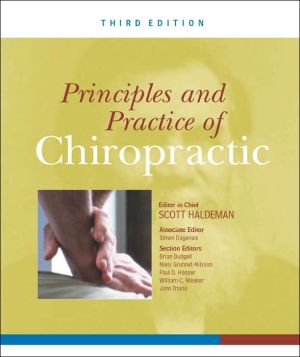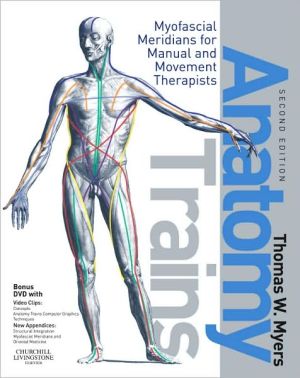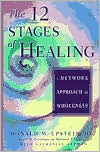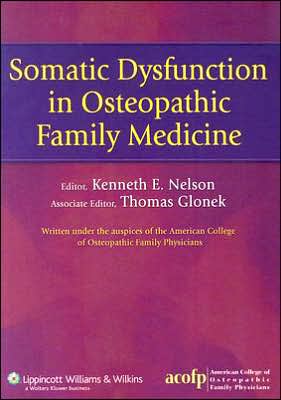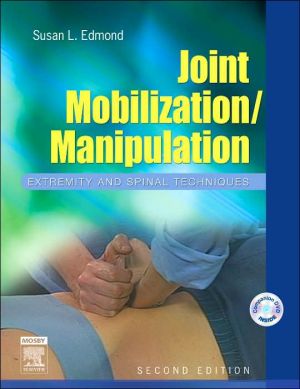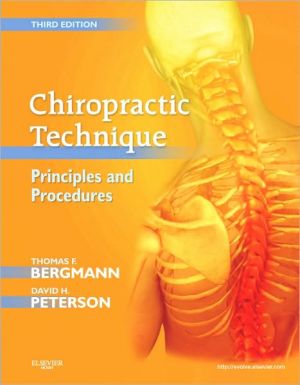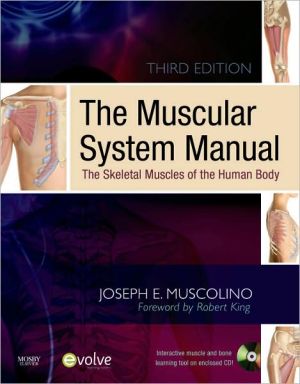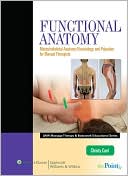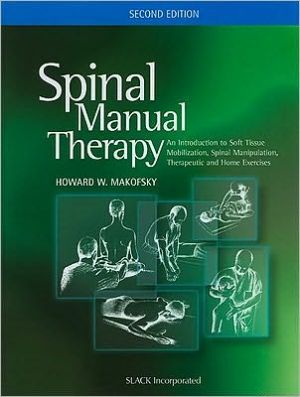Principles and Practice of Chiropractic
The most comprehensive, extensively illustrated book focusing on chiropractic principles, diagnosis, and treatment.\ A Doody's Core Title ESSENTIAL PURCHASE for 2011!\ 5 STAR DOODY'S REVIEW!\ "This is the third edition of one of the chiropractic profession's most important and influential books. It is a compendium of hard scientific knowledge about all aspects of chiropractic, from the social and historical to the clinical and research oriented. It is a significant expansion from the second...
Search in google:
PRINCIPLES & PRACTICE OF CHIROPRACTICThird EditionScott Haldeman, DC, MD, PhD (Editor-in-Chief)Completely Revised and UpdatedCHIROPRACTIC CLASSICPrinciples and Practice of Chiropractic is the most complete and authoritative textbook of chiropractic available. It provides a comprehensive overview of the entire field of chiropractic, including its history and philosophy, social implications, basic sciences, examination techniques, treatment methods, and management of specific disorders. Drawing on the expertise of private practitioners, scientists, health researchers, public health officers, and university instructors from thirty-three institutions, chapters are written by the world’s leading authorities. Multidisciplinary in nature, it incorporates important discoveries from a variety of fields as they relate to chiropractic.FEATURING NEW SECTIONS ON:- Geriatrics- Pediatrics- Clinical nutrition- Rehabilitation- AcupunctureIDEAL FOR CHIROPRACTIC EDUCATION AND CLINICAL PRACTICEEach chapter in this book includes:- Learning objectives- Multiple-choice questions and answers- Key references for further studyDr. Haldeman bridges the disciplines of medicine and chiropractic through his education, research endeavors and scholarly publishing. Haldeman is the most respected name in chiropractic today. He travels through out the world presenting on both medical (neurology) and chiropractic topics and he is a on the editorial boards of such renowned peer-reviewed journals as JMPT, Spine, and The Back Letter. Booknews Developed as a core text for the chiropractic student and as a reference, meets the needs of the profession to present positions, theories, philosophy, and treatment in terms that are understood and accepted by other health care professionals. Updates the first edition published in 1980. Annotation c. Book News, Inc., Portland, OR (booknews.com)
ContributorsPrefaceAcknowledgementsIHistory, Philosophy, and Sociology11Spinal Manipulation Before Chiropractic32Medical and Social Protest as Part of Hidden American History153Origin and Development of Traditional Chiropractic Philosophy294Contemporary Chiropractic Philosophy455The Sociology of Chiropractic: Future Options and Directions53IIPhysiological and Biomechanical Principles616Spinal Anatomy: The Relationship of Structures637Physiology of Nerve Compression738Spinal Reflex Physiology879Clinical Investigations of Reflex Function10510Systemic Effects of Spinal Lesions11511Biomechanics of the Cervical Spine13712Biomechanics of the Lumbar Spine14913The Neurophysiology of Spinal Pain16514Pathophysiology of the Intervertebral Disc18515The Pathophysiology of Zygapophyseal Joints19716Pathophysiology of the Sacroiliac Joint21117Interaction of Spinal Biomechanics and Physiology225IIISpinal Analysis and Diagnostic Methods25918The History and Physical Examination26119Manual Examination of the Spine30120The Use of Instrumentation and Laboratory Examination Procedures by the Chiropractor31921Spinal X-Rays36122Advanced Imaging Modalities37523Spinal Imaging and Spinal Biomechanics391IVChiropractic Care41324Effectiveness of Spinal Manipulation and Adjustments41525Basic Principles in the Performance of Chiropractic Adjusting: Historical Review, Classification, and Objectives44326The High-Velocity Thrust Adjustment45927Diversified Technique48328Traction and Distraction Techniques50329Soft Tissue and Nonforce Techniques51930Spinal Rehabilitation53331Musculoskeletal Complications54932Cerebrovascular Complications of Manipulation579Appendix A. Chiropractic Growth Outside North America599Appendix B. Chiropractic Glossary of Commonly Used Terms621Index629
\ From The CriticsReviewer: Dana J Lawrence, DC, MMedEd, MA(Palmer College of Chiropractic)\ Description: This is the third edition of one of the chiropractic profession's most important and influential books. It is a compendium of hard scientific knowledge about all aspects of chiropractic, from the social and historical to the clinical and research oriented. It is a significant expansion from the second edition, which was published in 1992, quite some time ago. It contains five major sections: Introduction to Principles of Chiropractic, Introduction to Chiropractic Theory, Introduction to the Clinical Examination, Introduction to Specific Treatment Methods, and Introduction to Management of Specific Disorders.\ Purpose: The purpose is to revisit and update the 1992 edition, using information provided by chiropractic clinical scientists and scholars. This is then an overview of chiropractic theory and practice. Given that the last edition of this book is 12 years old, this new edition was sorely needed, and its reality is a great boon to chiropractic education. The book exceeds all expectations the author had for it.\ Audience: This is directed at chiropractic physicians and students, and is a superb teaching text for students in particular. It is also useful for anyone with an interest in the most modern educational standards for chiropractic theory and practice. The author is the leading chiropractic researcher and scholar, now an elder statesman for the profession and the section heads are among the most respected in the chiropractic research/academic community.\ Features: There are many new chapters, and virtually the entire rest of the book has been rewritten. The number of authors has increased substantially, and all are among the most respected and active in their fields. Each chapter is well written and edited, and each covers a substantial amount of ground. The thoroughness of this book is breathtaking; it gives a complete and comprehensive overview of modern chiropractic theory and practice. \ Assessment: This is a critical "must have" book. The original edition and its 1992 revision are among the most respected of all chiropractic texts, and in part form the basis for how modern chiropractic is taught. This book updates and expands upon that information, adding new chapters covering areas of current interest that did not even exist in 1992. This is vastly expanded edition. It is a testament to the growth of chiropractic research that a new book could be conceived. I consider this the most essential of all chiropractic texts, one that all chiropractors should obtain.\ \ \ \ \ From The CriticsReviewer: Dana J Lawrence, DC, MMedEd, MA (Palmer College of Chiropractic) \ Description: This is the third edition of one of the chiropractic profession's most important and influential books. It is a compendium of hard scientific knowledge about all aspects of chiropractic, from the social and historical to the clinical and research oriented. It is a significant expansion from the second edition, which was published in 1992, quite some time ago. It contains five major sections: Introduction to Principles of Chiropractic, Introduction to Chiropractic Theory, Introduction to the Clinical Examination, Introduction to Specific Treatment Methods, and Introduction to Management of Specific Disorders.\ Purpose: The purpose is to revisit and update the 1992 edition, using information provided by chiropractic clinical scientists and scholars. This is then an overview of chiropractic theory and practice. Given that the last edition of this book is 12 years old, this new edition was sorely needed, and its reality is a great boon to chiropractic education. The book exceeds all expectations the author had for it.\ Audience: This is directed at chiropractic physicians and students, and is a superb teaching text for students in particular. It is also useful for anyone with an interest in the most modern educational standards for chiropractic theory and practice. The author is the leading chiropractic researcher and scholar, now an elder statesman for the profession and the section heads are among the most respected in the chiropractic research/academic community.\ Features: There are many new chapters, and virtually the entire rest of the book has been rewritten. The number of authors has increased substantially, and all are among the most respected and active in their fields. Each chapter is well written and edited, and each covers a substantial amount of ground. The thoroughness of this book is breathtaking; it gives a complete and comprehensive overview of modern chiropractic theory and practice. \ Assessment: This is a critical "must have" book. The original edition and its 1992 revision are among the most respected of all chiropractic texts, and in part form the basis for how modern chiropractic is taught. This book updates and expands upon that information, adding new chapters covering areas of current interest that did not even exist in 1992. This is vastly expanded edition. It is a testament to the growth of chiropractic research that a new book could be conceived. I consider this the most essential of all chiropractic texts, one that all chiropractors should obtain.\ \ \ BooknewsDeveloped as a core text for the chiropractic student and as a reference, meets the needs of the profession to present positions, theories, philosophy, and treatment in terms that are understood and accepted by other health care professionals. Updates the first edition published in 1980. Annotation c. Book News, Inc., Portland, OR booknews.com\ \
